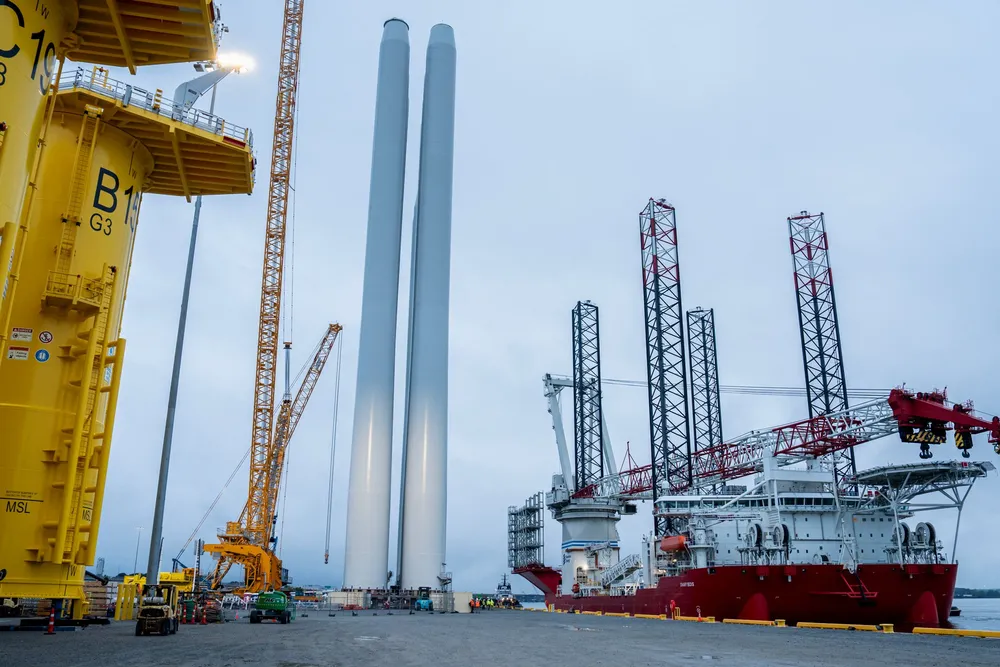Will Charybdis be the high-water mark of US offshore wind shipbuilding?
Nation's one and only WTIV an achievement for American manufacturing but launched into a much diminished sector

The Jones Act is a US maritime law that bans foreign-flagged vessels from calling in at consecutive US ports or points on the outer continental shelf, including wind turbine foundations. The five US projects currently in construction must deploy costly and higher risk workarounds of domestically-built barges feeding foreign-flagged WTIV that remain at the lease site.
It’s also packed with US content, including 14,000 tonnes of steel, most of it produced in Alabama, North Carolina, and West Virginia.
Some 2,000 workers laboured on its construction, a major boost for the local economy and in line with President Donald Trump’s vision of reviving the nation’s maritime industries.
Struggling shipbuilding
American shipbuilding has fallen far behind its rivals, with US-flagged vessels accounting for less than 1% of the global commercial fleet, compared to China’s nearly 60% share, according to business consultancy McKinsey.
“It is the policy of the United States to revitalise and rebuild domestic maritime industries and workforce to promote national security and economic prosperity,” the EO added.
Through this and other executive actions, the president has put his weight behind commercial and defence shipbuilding.
The Trump-backed Big Beautiful Budget Bill (BBB) includes more than $29bn for procurement of naval vessels, with another $5bn for shipyards to invest in technology and infrastructure. Another $24.6bn is granted to the Coast Guard for mission readiness.
At the same time he’s looking to rebuild US shipbuilding, though, Trump is also trying to kill a key market for its shipyards – offshore wind.
War on wind
The president has even gone after the few projects in construction, including Orsted’s Revolution Wind, 80% complete as of August when it was hit with a surprise stop-work order.
Red state investment
Revolution, as part of Orsted’s trio of advanced arrays that includes the already operational 132MW South Fork as well as the 920MW Sunrise, both to New York sparked hundreds of millions in investment in US ports and vessels.
Orsted put down $100m for Connecticut marshalling hub New London State Pier and another $100m in Rhode Island ports.
The largesse is not limited to the largely Democratic Northeast states but has permeated throughout Republican-dominated industrial belts.
Upskilling US shipyards
Offshore wind didn’t just prompt orders for new vessels but advanced US shipbuilding technology and skills, Burbelo said.
The industry “introduced a higher level of outfitting and creature comforts for both the crew and passengers, promoting growth in US building and design,” he said.
Under Jones Act market protection, US yards have had little incentive to invest in capacity building or technology advancement. For offshore wind, however, American shipyards were forced to upgrade to global standards, leading to “workforce development where skills were previously lacking,” Burbelo said.
Overall, offshore wind has initiated “a beneficial shift towards higher quality vessels,” he added.
This success was hard won by the industry, with “a lot of lessons-learned regarding contract confidence and vessel build times,” said Burbelo.
The policy reversal by the Trump administration and collapse of orders means “advantages gained during consecutive vessel production and the retention of skilled labour will be lost in the current period of uncertainty.”
Trump’s heightened import controls and tariffs “will only add to cost and uncertainty in future project bids,” he added.
Strict deadlines and the need for scarce skilled labour sent costs skyward, and at least one shipyard claimed “nobody made money” in the sector.
These shipyards said they preferred to build simpler steel vessels for the military being promoted by the Trump administration.
“In the short/mid-term, she’ll likely have to support US O&M [operations and maintenance]. Who knows about the future at the moment!” he said.
(Copyright)